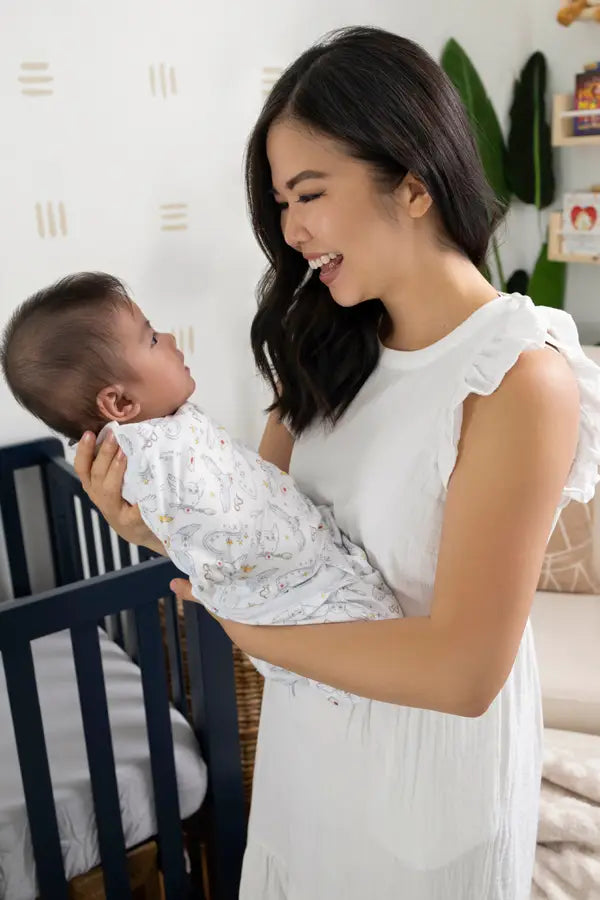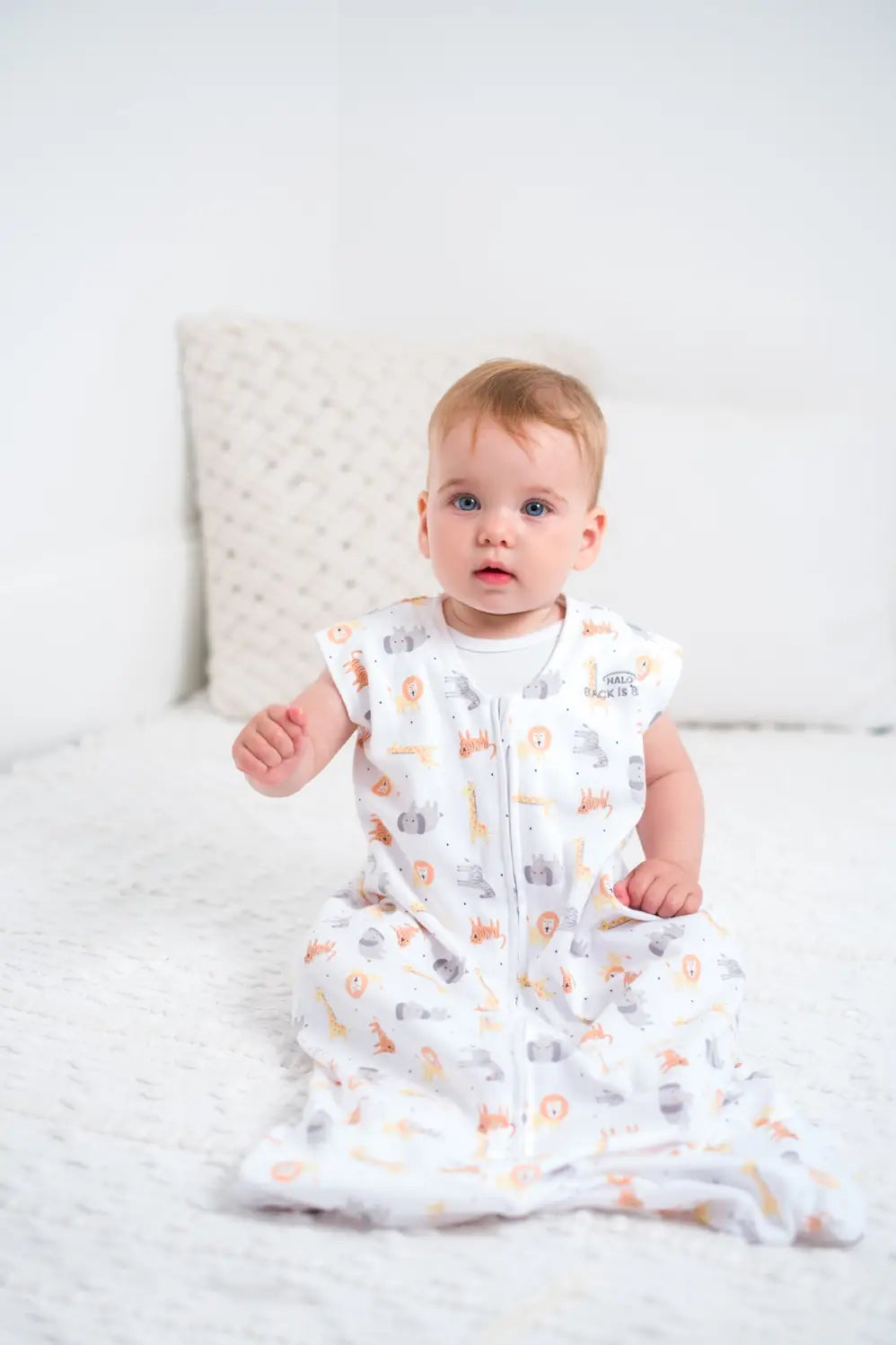WHAT TO CHOOSE: SLEEPING BAG OR SWADDLE?
ORIGINALLY POSTED: 6 October 2022

As parents, you are bombarded from the very beginning with decisions to make!
While pregnant, you have to decide where to give birth and who your child's pediatrician will be. Then, the decisions just keep coming once the little one arrives: cot or bassinet, breastfeed or bottle feed (or both), puree foods or baby-led feeding? It never ends!
The good news is that if you have all of the information to guide your decision making process then it becomes a lot less stressful on you to figure out what’s best for you and your family.
When it comes to your little one’s sleep, there are a variety of choices you face as new parents. One we often hear is, “Should I use a swaddle or a sleeping bag?” In the swaddle vs. sleeping bag debate, there are a couple of key things you want to consider before making a decision.
First, you want to make sure you are familiar with safe sleep practices. This includes guidelines set by the American Academy of Pediatrics (AAP) to help reduce the risk of sudden infant death syndrome or SIDS. This is most common in a little one’s first few months of life.
- To reduce the risk of SIDS, the AAP recommends:
- Having infants sleep on their backs on a firm breathable mattress free of any loose sheets
- It is strongly discouraged to bedshare with your infant
- It is ideal to room share for first six months, up to a year if possible
- Maintaining an ideal room temperature of 20° to 22°C (68° and 72°F )
- Removing any loose blankets or toys from the bed
But parents want to make sure their little ones stay warm at night, which is why the “no blankets” rule can seem tough. However, there are many ways to keep your baby safe AND cosy warm while they sleep.
Now, it’s time to educate yourself on safe sleep products such as looking at the benefits of a sleeping bag vs a swaddle. Knowing the difference between swaddles and sleeping bags can help you make an informed decision.
Here is a detailed breakdown of the difference between a swaddle and sleeping bag, when to use each, and how many you might need to help you make the best choice for you and your family!
What is a Swaddle?
A swaddle is a blanket designed to swaddle your baby, specifically your newborn. Swaddling your little one means wrapping the blanket securely around them so that they are unable to wriggle out. When using swaddles, you’ll want to make sure you are still using safe sleep practices.
Here are a few things to consider when using swaddle blankets or products:
- Always swaddle with a baby on their back.
- Make sure the swaddle is snug and appropriately sized to reduce the risk of fabric coming loose and accidentally covering a baby’s mouth or nose.
- Do not tightly swaddle your baby’s hips. They should be able to freely move their legs to help aid in hip development. The HALO® SleepSack® swaddle is recognised as "hip healthy" by the International Hip Dysplasia Institute.
With this in mind, swaddles are a great option for a few reasons:
- The snugness of a swaddle mimics the snugness of the womb. This can be comforting for newborns and help them sleep for longer stretches at a time.
- Prevents the startle reflex in newborns which can be a frequent cause of waking up.
- Keeps newborns warm and comfy without using loose blankets
Traditional swaddle blankets are large blankets made of soft, stretchy, and breathable fabric like muslin or cotton. You also have the option of 3-in-1 swaddles like the HALO® SleepSack® swaddle. With adjustable velcro swaddle fasteners, you can easily swaddle your baby three different ways: arms in, hands-to-face, or with one or both arms out.
How Long Do Babies Use a Swaddle?
When it comes to deciding on a swaddle or sleeping bag for a newborn, your best bet will be with the swaddle! This can be done in the first day of their life and often provides comfort to fussy newborns struggling to sleep.
However, as great as swaddling is, it is important to note one drawback in the swaddle vs sleeping bag debate. At a certain point, swaddles can become dangerous for babies. This is why it is critical to know when to stop using them and transition from the swaddle.
The primary behavior that indicates your swaddle days are coming to an end is your child starting to roll over on their own. This typically happens around 4 months, but for some babies, it can happen much earlier!
When this happens, it takes the decision of sleeping bag or swaddle out of your hands! It’s time to transition out of the swaddle and into a sleeping bag.
What is a Sleeping Bag?
When deciding between a sleeping bag and a swaddle, it’s important to make sure you know exactly what a sleeping bag is. It is not the same thing as a swaddle despite people sometimes misusing the two terms interchangeably.
While a swaddle is typically a soft blanket, sleeping bags (also called wearable blankets or blanket sleepers) are bodysuits made of a blanket-like material with a hole for your baby’s head and two holes for their arms. The loose fitting “sack” allows your little one to move their legs but does restrict mobility somewhat.
Typically, sleeping bags can come with zipper, velcro, snaps, or some combination of the three. For example, the HALO® Wearable Blanket has an inverted zipper for easy diaper changes during the night.
Just like a swaddle, a sleeping bag helps to keep your little one warm and safe as it eliminates the need for loose blankets.
Are Sleeping bags Safe?
We hear this question a lot in the wearable blanket vs swaddle discussion, and the answer is: yes! In fact, when used properly, sleeping bags actually make sleep safer as they keep little ones warm while at the same time lowering the risk of SIDS. They also eliminate the need for loose blankets which is not recommended for children under the age of one.
Are Sleeping bags Safe for Newborns?
When it comes down to deciding whether or not to use a swaddle or sleeping bag for a newborn, it is important to pay attention to where your baby is developmentally. If they’re starting to roll over or even if they're showing signs of rolling over, a sleeping bag is a safer choice!
Until your baby is rolling over on their own, it is completely safe to choose a swaddle. As long as you practice safe swaddling habits and it is what your baby prefers, swaddle blankets are a great choice for newborns.
How Long Do Babies Use Sleeping Bags?
When it comes to deciding on a sleeping bag or a swaddle, it is important to note that parents are typically able to get more use out of sleeping bags. That is because swaddles become unsafe once infants start to roll over, which happens around 4 months. On the other hand, sleep sacks can be worn as long as 24 months old and into toddlerhood.
The exact time will vary by baby. As your little one starts to develop more, such as rolling over, crawling, and pulling up, they will most likely start testing these new found skills in their bed. Some will get frustrated by having their legs confined which might make it difficult for them to fall asleep or go back to sleep. Also, if your little one is able to get out of their cot or bed on their own, a sleeping bag makes it difficult (and unsafe) to walk.
When this starts to happen, it’s time to consider transitioning away from the sleeping bag. At this point, it is no longer a discussion of choosing a wearable blanket or swaddle, but it is time to determine whether or not your child is ready for a loose blanket.
Keep in mind that the AAP does not recommend using a loose blanket for your little one until they are at least one year old. If your child is showing signs of being done with a sleeping bag prior to that, we recommend looking for alternative safe sleep products.
At the end of the day, your baby is safe to wear a sleeping bag as long as they want to and as long as they are able to fit in one!
How Many Sleeping Bags Do I Need?
Since sleeping bags can be worn for a much longer period of time than a swaddle, you want to make sure to have enough! The exact number will depend on you and your baby.
Although before you start adding items to your cart or baby registry, it is important to know that sleeping bags come in a variety of sizes. Manufacturers typically include a sizing guide based on age, height, and weight.
The most important of those three are height and weight because no two babies are alike! Some 6 months old can weigh as much as a toddler! Carefully examine the height and weight recommendations of any sleeping bag before making a decision on which size and how many to buy.
Once you’ve educated yourself on safe sleep practices and your options of the safe sleep products on the market, you are ready to make the decision: swaddle or sleeping bag (or both!). It won’t be the last decision you make as a parent, but hopefully with the right information, the decision making process is less stressful!

